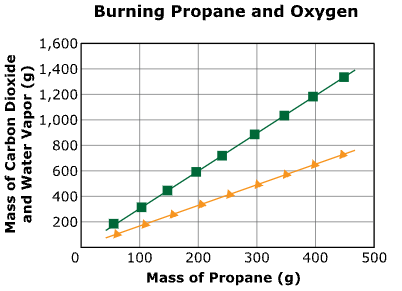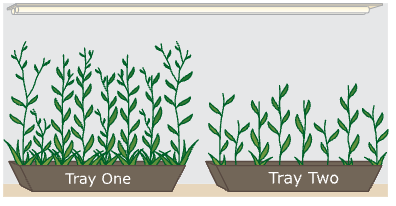FREE ISASP Science Questions and Answers
A flammable liquid called propane was used in an experiment by a researcher to study mass conservation. In several trials, the researcher burnt propane in the presence of oxygen. The mass of carbon dioxide and water vapor created during each trial was calculated by the researcher, who then graphed the results.
Which experimental finding most strongly suggests the presence of a chemical reaction?

Explanation:
In a chemical reaction, new substances are formed as a result of the rearrangement of atoms. In this experiment, propane (C3H8) reacts with oxygen (O2) to produce carbon dioxide (CO2) and water vapor (H2O), which are different substances than the reactants. This change in substances indicates that a chemical reaction has occurred.
Which of the following is required for a plant to produce glucose?
Explanation:
Plants require carbon dioxide from the air as one of the raw materials for photosynthesis, the process by which they produce glucose. During photosynthesis, carbon dioxide is combined with water in the presence of sunlight to create glucose and oxygen. Therefore, carbon dioxide is essential for plants to synthesize glucose and produce energy.
In two nearby farms, the researchers measured the amount of soil lost in kilograms per hectare (kg/ha). Every field was divided into two parts of the same size, one with radish ground cover and the other without. The graph below displays the results.
Why did the researchers select two fields that were close to each other?

Explanation:
Selecting two neighboring fields ensures that they are subjected to similar environmental factors such as weather patterns, soil composition, and topography. This allows for a more accurate comparison of the effectiveness of radish ground cover in reducing soil loss between the two fields.
In two nearby farms, the researchers measured the amount of soil lost in kilograms per hectare (kg/ha). Every field was divided into two parts of the same size, one with radish ground cover and the other without. The graph below displays the results.
Before the start of the study, the scientists examined the fields. Which of the scientists' observations had the biggest impact on the study's findings?

Explanation:
The slope of the field can significantly impact soil erosion. A steeper slope in Field A would likely result in greater soil loss compared to Field B, even with similar ground cover conditions. Therefore, the slope of the fields would have a considerable effect on the study's results.
Students created an experiment to investigate what happens to water when it freezes. They filled multiple plastic containers of the same size with 50 milliliters (mL) of pure water. They placed each container in the freezer after covering it. Once the water became frozen, they measured the amount of ice present in each container.
Although the right procedures were followed, a student accidentally filled her container with 60 mL of water.
Which of these volumes of ice did she most likely observe once she took it out of the freezer?
Explanation:
Since the water expands as it freezes, the volume of ice formed will be slightly larger than the volume of the liquid water. Therefore, the student would most likely observe 60 mL of ice after removing it from the freezer, corresponding to the volume of water she poured into the container.
In two identical trays, a student planted multiple cuttings of the same size from one parent plant. The student put the cuttings in nutrient-rich soil in Tray One. The student placed the cuttings in nutrient-poor soil in Tray Two. Trays One and Two were positioned beneath the same light source. For two weeks, the student watered the cuttings in each tray with the same quantity of water each day. After two weeks, the plants in Trays One and Two are shown in the pictures below.
For an extra week, the student continued the experiment. At the end of the extra week, what did the student probably observe?

Explanation:
Since Tray One contained nutrient-rich soil and Tray Two contained nutrient-poor soil, the plants in Tray One likely had better access to essential nutrients, resulting in healthier growth. Even after the extra week, this difference in nutrient availability would likely persist, with the plants in Tray One continuing to outgrow those in Tray Two.
In two identical trays, a student planted multiple cuttings of the same size from one parent plant. The student put the cuttings in nutrient-rich soil in Tray One. The student placed the cuttings in nutrient-poor soil in Tray Two. Trays One and Two were positioned beneath the same light source. For two weeks, the student watered the cuttings in each tray with the same quantity of water each day. After two weeks, the plants in Trays One and Two are shown in the pictures below.
What was the purpose of the student using cuttings from one parent plant?

Explanation:
By using cuttings from one parent plant, the student ensures that the genetic makeup of the plants in both trays is identical. This eliminates genetic variation as a factor influencing the observed differences in growth between the two trays. Thus, any differences observed between Tray One and Tray Two can be attributed to the different soil conditions (nutrient-rich vs. nutrient-poor) rather than genetic differences among the plants.
A flammable liquid called propane was used in an experiment by a researcher to study mass conservation. In several trials, the researcher burnt propane in the presence of oxygen. The mass of carbon dioxide and water vapor created during each trial was calculated by the researcher, who then graphed the results.
According to the researcher, when propane and oxygen react, carbon dioxide is created at a higher rate than water vapor. Which graph's evidence most strongly supports the researcher's claim?

Explanation:
The evidence from the graph that supports the researcher's claim is the consistent trend where the mass of carbon dioxide produced was consistently greater than the mass of water vapor produced across multiple trials. This consistency indicates that more carbon dioxide is produced than water vapor in the reaction between propane and oxygen.
Students created an experiment to investigate what happens to water when it freezes. They filled multiple plastic containers of the same size with 50 milliliters (mL) of pure water. They placed each container in the freezer after covering it. Once the water became frozen, they measured the amount of ice present in each container.
After taking his container out of the freezer, a student left it open under a sunny window. What did the student most likely see in the container the next school day, assuming it was undisturbed?
Explanation:
Leaving the container uncovered in a sunny window would likely lead to some of the ice melting due to the warmth of the sunlight. Since the original volume of water was 50 mL, the student would most likely observe 49 mL of liquid water remaining in the container the following school day.
During photosynthesis, what happens to the glucose produced?
Explanation:
During photosynthesis, plants convert carbon dioxide and water into glucose, which is a type of sugar. This glucose serves as an energy source for the plant, fueling various life-sustaining processes such as growth, reproduction, and cellular respiration.
In two nearby farms, the researchers measured the amount of soil lost in kilograms per hectare (kg/ha). Every field was divided into two parts of the same size, one with radish ground cover and the other without. The graph below displays the results.
Which of the scientists' claims are best supported by the facts they gathered?

Explanation:
This claim is best supported by the data because it directly compares the soil loss between sections with and without ground cover in each field. The data show a consistent reduction in soil loss in sections with radish ground cover compared to sections without ground cover in both fields, supporting the claim that radish ground cover significantly reduces soil erosion.